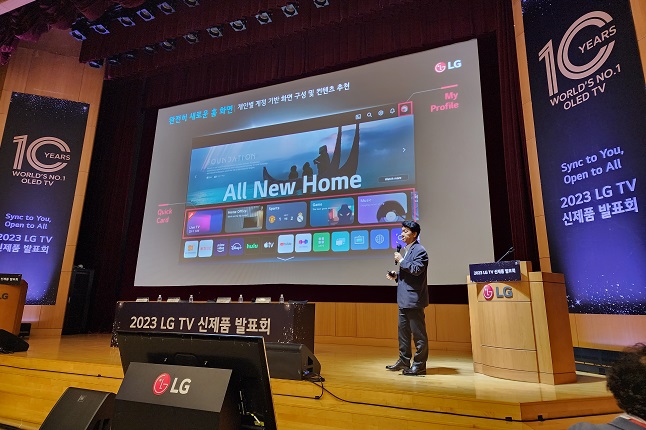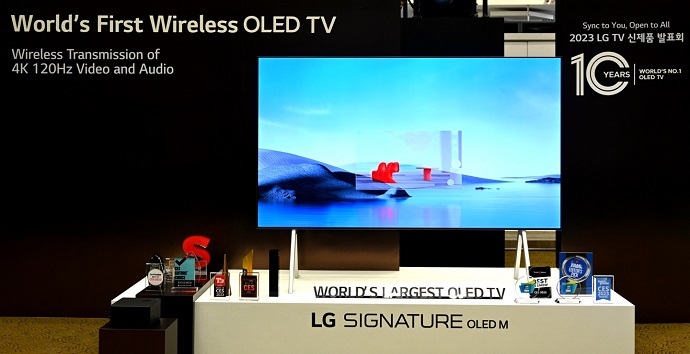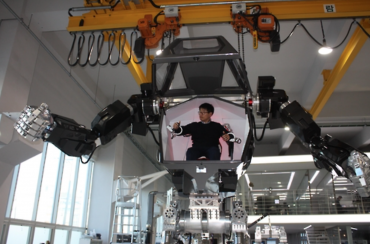
Baik Seon-pill, vice president and head of LG’s TV product planning division, makes a presentation on the tech company’s new OLED TV lineup at Seocho R&D Campus in southern Seoul on March 8, 2023. (Yonhap)
SEOUL, March 8 (Korea Bizwire) — LG Electronics Inc. said Wednesday it expects its TV business, centered around premium OLED TVs, to log an on-year growth this year despite sluggish demand amid stubbornly high inflation.
“While the global TV market is likely to shrink this year due to lingering business uncertainties, we expect our TV business to grow slightly compared with last year,” Baik Seon-pill, vice president and head of LG’s TV product planning division, said at a press event to announce a new lineup of OLED TVs for this year.
Baik said LG’s state-of-the-art display technologies and customization services to make the TV experience more personal and enjoyable will help the South Korean tech company achieve the goal.
The event took place at LG Electronics’ Seocho R&D Campus in southern Seoul, where the company held a press conference 10 years ago to launch its first self-luminous OLED TVs.
“While OLED TVs are undeniably the mainstream product today, only LG Electronics truly believed in its potential more than 10 years ago,” Jung Jae-cheol, senior vice president and leader of Home Entertainment (HE) R&D Lab, said.
“Being a pioneer, LG has made history in the OLED market,” he said, adding that “Now, 21 TV brands are producing OLED TVs” to grab a slice of the growing high-end TV segment.
“This demonstrates that consumers have acknowledged the value of OLED TVs, and LG made the right decision,” he said.
LG, which has a 60 percent market share of the global OLED TV market, said it will begin launching new OLED TVs, 29 models in seven series, in select markets Monday.
New products include the LG OLED evo in 55, 65, 77 and 82 inches, fitted with advanced artificial intelligence chips and technology features that boost brightness by around 70 percent compared with existing OLED TVs and reduce reflection of light on the screen.
A new model of the world’s biggest OLED TV at 97 inches will be launched within this year.

This photo, provided by LG Electronics Inc., shows the LG Signature OLED, which the global home appliances giant unveiled during an event to introduce its new TV products for this year in Seoul on March 8, 2023.
OLED evo is the major TV maker’s second-generation OLED panel, with more light per pixel than before and improved brightness and better color accuracy.
Blacks are deeper and darker, and other colors are richer and creamier on LG OLED evo TVs, according to the company.
LG’s latest TVs became smarter with an improved artificial intelligence processor, the company said, which enables show producers to easily execute their intentions when making certain scenes and automatically adjusts the brightness and other effects.
WebOS, LG’s own smart TV operating system, offers more than 2,500 applications and is fitted with a more advanced recommendation algorithm tailored to individual tastes and needs, according to the company.
LG is counting on the success in the high-margin, premium TV segment to keep its competitive edge over rivals.
The tech firm’s operating income nose-dived more than 90 percent during the October-December quarter on a sharp drop in demand for home appliances and rising promotion costs amid global macroeconomic woes.
Aggressive rate hikes in major economies to bring inflation under control have significantly weakened consumers’ spending power.
According to research firm TrendForce, global TV panel shipments are forecast to decline 2.8 percent on-year to 264 million units this year, but shipments of OLED panels are expected to grow.
OLED TVs, which account for nearly half of the premium TV market, priced at $1,500 or over, are predicted to grow 14 percent from a year ago, according to Omdia.
LG said it will continue expanding its smart TV platform to diversify its business portfolio and maintain its competitive edge in the premium TV segment by offering various form factors.
(Yonhap)






